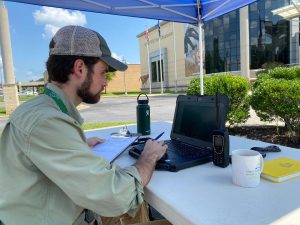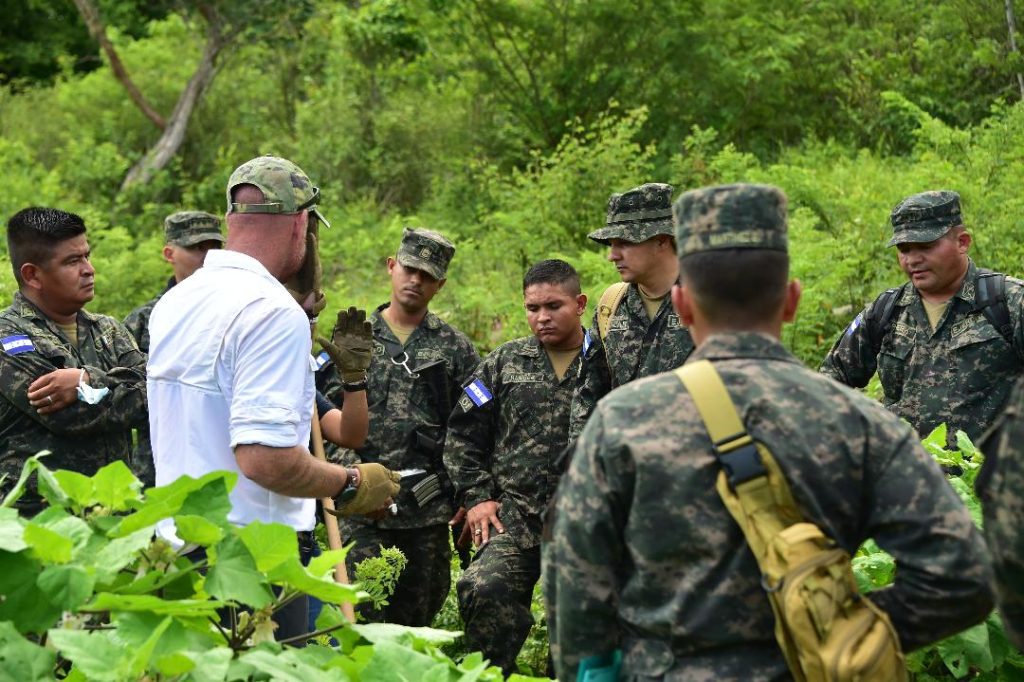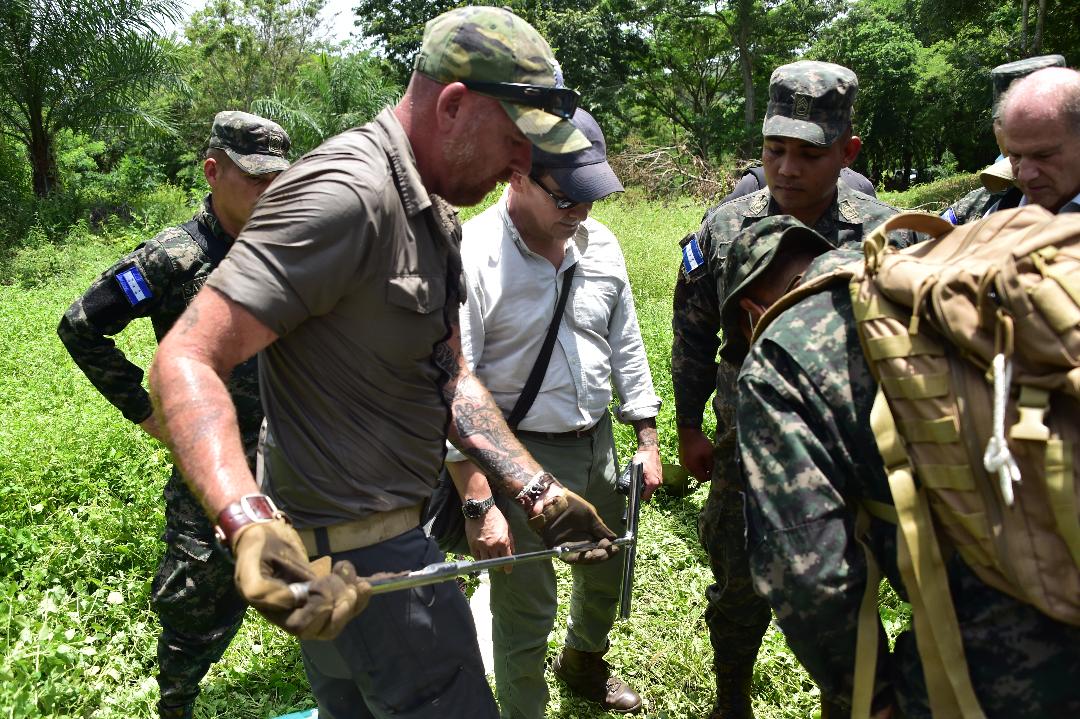
By Callie Hietala
The storied Monuments Men unit of World War II has been reactivated for the modern age, and part of their new operation, the Cultural Heritage Monitoring Lab (CHML), is headquartered in Martinsville at the Virginia Museum of Natural History (VMNH). This lab allows its director, VMNH Assistant Curator of Archaeology Dr. Hayden Bassett, to use state-of-the-art satellite technology to monitor the condition important cultural sites all around the world and, when necessary, coordinate with military personnel during active missions from a virtual command center at the Museum.
The historical Monuments Men were a group of 345 men and women, many with backgrounds as curators, art historians, artists, museum directors, and librarians, who, from 1943 to 1951, worked to protect monuments and other cultural artifacts from destruction during World War II. Some were even on the front lines to locate and recover art and artifacts looted by the Nazis. Two Monuments Men were killed in combat. As the war came to an end, the Monuments Men helped to return more than five million cultural objects to their rightful home countries.
That legacy is the inspiration behind this new endeavor, the U.S. Army Monuments Officer Training (AMOT) program, which was announced in 2019. Bassett said that, though reactivating the unit had been an ongoing effort for some time, the looting of the National Museum of Iraq in 2003 spurred the Army into action. Corine Wegener, the director of the Smithsonian Cultural Rescue Initiative (SCRI), was the uniformed cultural heritage professional on site to lead the initial response at the National Museum.

“Since then, it has been widely recognized that not only is there an intrinsic value to these types of preservation activities in armed conflict and natural disasters, but also an instrumental value for building relationships with a host of nations.”
The new group of Monuments Men (and women) is comprised of Army Reservists who, like the Monuments Men of the past, are museum professionals, conservators, archaeologists, or other cultural heritage specialists. The program itself is a partnership between the Army Reserve’s U.S. Army Civil Affairs and Psychological Operations Command (Airborne) and SCRI. Bassett was inspired to join after reading a 2019 New York Times entitled “The Army is Looking for a Few Good Art Experts.” He is now in the final stages of the two-year process of commissioning into the Army Reserves as part of the Monuments Men unit.
As the reactivated unit began to take form, Bassett said “we realized that it’s going to take more than just Army Reserve officers on their limited duty time to accomplish” the mission. When he joined the staff at VMNH in 2020, Bassett said he volunteered to be the applied research lab to support unit operations through a partnership with SCRI.
“In World War II they had the exact same thing, an applied research lab consisting of volunteer librarians, curators, and art experts based at the Frick Museum in New York, and they were working full-time producing maps, actually delivering the research and information that the Monuments Men in the field in the Pacific and European theaters needed to accomplish what they were able to accomplish. We’re taking that as our model and applying it here. To my knowledge, we’re the only museum in the world with satellite tasking capability and advanced satellite communications.”
According to the museum’s website, the CHML “operates through a distributed workforce of archaeologists, art historians, GIS experts, and student interns. Among other technologies, the CHML utilizes high-resolution satellite imagery provided by industry partners to rapidly identify destructive events and active threats to monuments, museums, archives, historic buildings, archaeological sites, and landscapes.”
Currently, the lab is monitoring threatened cultural heritage sites in the Ukraine, Armenia, Azerbaijan, Afghanistan, Ethiopia, Djibouti, and Honduras. The Army builds partnerships with the nations it works with, training its own military personnel in site assessment work so that, eventually, the nations will be able to assess and protect those sites independently.
In 2020, Honduras, one of the partner nations, was hit by two hurricanes.
“We worked directly with NASA Jet Propulsion Lab,” Bassett said. “We received impact data from them from these two hurricanes, and we were able to model the countrywide impacts to cultural heritage sites for them. And from that, we produced 30 sites that are probable direct impacts.”

Recently, Bassett and a ground team of Army Monuments Men officers, working alongside Honduran military, participated in their first live, in-field impact assessment mission using the CHML as a mobile command unit. The team was tasked with assessing the condition of two ancient Mayan sites—Dos Quebradas and Talgua. He invited the Henry County Enterprise for an exclusive look at the CHML and Monuments Men in action.
Bassett sets up in the parking lot of the museum, a blue pop-up tent is the only thing between him and the sweltering summer sun. On a plastic folding table is his computer, a cup of coffee, stacks of forms on which to record data transmitted by the ground team in Honduras, and a high-tech Iridium satellite phone. This is all he needs for his part of the operation. He opens a Zoom link with Dr. Kate Harrell, another Monuments Men colleague who will be assisting with the mission from Charlottesville. He pulls up high-resolution satellite imagery of the general location, overlays maps of the first Mayan site the team will be assessing and is ready to go.
A beep on the satellite phone alerts Bassett, via text, that the ground team has arrived in the town. Its members are making their way through the dense vegetation of Honduras toward the first location. “Copy,” Bassett texts back.
A bit later, another beep. This time, a message: “Confirm location.” This is followed by a set of coordinates. Bassett inputs the coordinates into the computer and confirms that the team has arrived at the first site of the day. Location confirmed, the ground team begins the site assessment.
Over the next several hours, the satellite phone beeps intermittently to let Bassett know a new message has come through. Sometimes, it is one of the soldiers asking for another location confirmation to ensure they haven’t wandered too far away from the site. Other times, though, it is to report that something has been found—a ceramic vase handle or sherd, evidence of animal burrowing, human activity.
Each time, Bassett fills out a sheet noting the coordinates and what was reported. His counterparts in Honduras are filling out copies of those exact same data sheets as well. Then, he inputs the data into the satellite image of the site. When necessary, he instructs the ground unit to take further action. When erosion is reported, he wants to know how far away it is from Structure 2. If it’s too close, it could pose a potential threat to the integrity of the structure and action may need to be taken. When coordinates come through that show a soldier is too far from the designated evaluation area, he tells them how far away they are and which direction they need to walk to get back to the mission area.
Sometimes the messages come in fast, one after the other. Sometimes there are long periods of quiet. But that is the work of the day.

While the mission may seem like a simple one, it is part of several larger, overarching goals. Most immediately, it is a training mission for the host nation that Bassett describes as a “subject matter expert exchange.” Local Honduran archaeologists are working directly with Bassett and other U.S. experts to create a combined response and combined training.
“At the end of the day,” Bassett said, “when the next disaster happens, it’s ideally going to be the Honduran military personnel who have been trained to respond and record.”
On a broader scale, the methods being tested during this mission can be applied elsewhere, including areas of conflict like Afghanistan and Iraq, where some of the world’s oldest cultural sites and treasures are found. The methods being employed here, real-time communication between military in the field and cultural experts like Bassett, allow for fast action to be taken if needed.
“Decision-making involving cultural heritage is often limited to the time that personnel are on a site in these situations,” said Bassett. “Returning to certain areas is often not an option because of security, time, or fiscal constraints for those people on the ground and in some cases, planning cannot wait for subject-matter-expert guidance before action is necessary. In this respect, windows of opportunity for preservation are often measured in the minutes and hours that a team is on site rather than the days or weeks after leaving a site and communicating that to a subject matter expert.”
Bassett said the CHML provided support during the recent withdrawal of U.S. military from Afghanistan.
“There’s a large team of cultural heritage professionals around the U.S. working on that. The leading institutions are the Smithsonian and the Penn Museum. We’re supporting by providing satellite imagery monitoring capability, so while they’re directly engaged with people on the ground, we’re the ones monitoring archaeological sites throughout Afghanistan and the National Museum in Kabul for any type of changes, impacts, evidence for looting, evidence for destruction.” Because of ongoing operations, Bassett could not share what the monitoring was revealing about the impact of the Taliban takeover.
So why did the U.S. military decide to invest time, money, and resources in reactivating the Monuments Men in the first place?
“A massive humanitarian response isn’t just going to involve living people,” Bassett said. “It’s also going to involve the infrastructure, which includes the cultural heritage of the country.”
“If certain aspects of cultural heritage just went away…” he trails off for a moment, thinking. “In Haiti, during the recent (earthquake), one of the largest impacts to that town was churches. So, if all the churches suddenly fell down, imagine what that would do to society. Regardless of your beliefs, there’s a major value in a civil society to having cultural heritage be part of everyone’s lives.”
The satellite phone beeps again, and Bassett goes back to work, eyes on his maps, phone in hand. Martinsville’s Monuments Man on the job, helping to protect and preserve culture all around the world.




